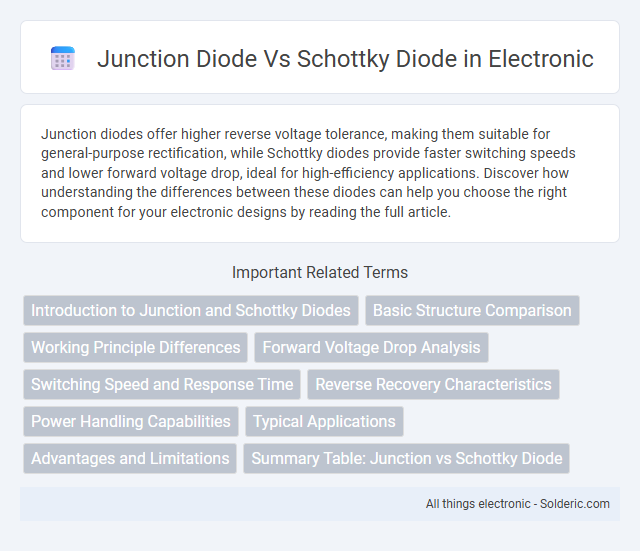Junction diodes offer higher reverse voltage tolerance, making them suitable for general-purpose rectification, while Schottky diodes provide faster switching speeds and lower forward voltage drop, ideal for high-efficiency applications. Discover how understanding the differences between these diodes can help you choose the right component for your electronic designs by reading the full article.
Comparison Table
| Feature | Junction Diode (PN Diode) | Schottky Diode |
|---|---|---|
| Construction | PN junction of p-type and n-type semiconductor | Metal-semiconductor junction |
| Forward Voltage Drop | 0.7 V (Silicon) | 0.2 to 0.3 V |
| Switching Speed | Slower due to minority carrier storage | Faster, no minority carrier storage |
| Reverse Recovery Time | High (microseconds) | Very low (nanoseconds) |
| Reverse Leakage Current | Low | Higher than PN junction diode |
| Applications | Rectifiers, signal diodes, general-purpose | High-speed switching, RF applications, power rectifiers |
| Noise | Higher noise | Lower noise |
| Temperature Sensitivity | Moderate | Higher sensitivity |
Introduction to Junction and Schottky Diodes
Junction diodes, also known as PN junction diodes, are semiconductor devices formed by joining P-type and N-type materials, enabling current flow primarily in one direction due to the depletion region at the interface. Schottky diodes, constructed from a metal-semiconductor junction, exhibit lower forward voltage drop and faster switching speeds compared to junction diodes. These characteristics make Schottky diodes ideal for high-frequency and low-voltage applications, while junction diodes are commonly used for rectification and signal modulation.
Basic Structure Comparison
A Junction Diode consists of a PN semiconductor junction formed by p-type and n-type materials, creating a depletion region that controls current flow. In contrast, a Schottky Diode features a metal-semiconductor junction, typically between a metal and n-type semiconductor, resulting in lower forward voltage drop and faster switching speed. Your choice depends on whether you need the higher efficiency and faster response of Schottky Diodes or the higher voltage tolerance of Junction Diodes.
Working Principle Differences
Junction diodes operate through the p-n junction, where current flows when forward biased, allowing charge carriers to recombine and create a depletion region that controls conduction. Schottky diodes utilize a metal-semiconductor junction, resulting in a lower forward voltage drop and faster switching speed due to the majority carrier flow without recombination. Understanding these working principle differences helps you select the appropriate diode type for high-speed or high-efficiency applications.
Forward Voltage Drop Analysis
Junction diodes typically exhibit a forward voltage drop ranging from 0.6 to 0.7 volts due to the silicon PN junction, affecting power efficiency in low-voltage applications. Schottky diodes feature a lower forward voltage drop, generally between 0.15 and 0.45 volts, attributed to their metal-semiconductor junction, which enables faster switching and reduced power loss. This characteristic makes Schottky diodes ideal for high-frequency circuits and power-sensitive designs where minimizing voltage drop is critical.
Switching Speed and Response Time
Junction diodes typically exhibit slower switching speeds and longer response times due to charge storage in the depletion region. Schottky diodes feature much faster switching speeds and minimal response times because they rely on majority carrier conduction without charge storage. Your choice depends on whether switching speed and low forward voltage drop are critical for your application.
Reverse Recovery Characteristics
Junction diodes typically exhibit slower reverse recovery times compared to Schottky diodes due to minority carrier storage, causing increased switching losses in high-speed applications. Schottky diodes leverage majority carrier conduction, resulting in negligible reverse recovery time and lower forward voltage drop, ideal for high-frequency circuits. Your choice between the two should consider these reverse recovery characteristics to enhance efficiency and reduce electromagnetic interference in power electronics.
Power Handling Capabilities
Junction diodes typically handle higher voltage and power levels due to their robust PN junction, making them suitable for power rectification in high-voltage circuits. Schottky diodes offer faster switching and lower forward voltage drop but have lower reverse voltage ratings and limited power handling capabilities compared to junction diodes. The power handling capacity of a junction diode often surpasses that of a Schottky diode, which is optimized for efficiency rather than high power.
Typical Applications
Junction diodes are commonly used in rectification circuits, signal demodulation, and voltage regulation due to their ability to handle higher reverse voltages and moderate switching speeds. Schottky diodes are preferred in high-speed switching and low forward voltage drop applications, such as power supply rectifiers, RF circuits, and clamping diodes, enhancing efficiency and reducing power loss. Your choice between these diodes depends on the specific requirements of speed, voltage, and efficiency in electronic circuit design.
Advantages and Limitations
Junction diodes offer higher reverse voltage tolerance and lower leakage current compared to Schottky diodes, making them suitable for high-voltage applications. Schottky diodes provide faster switching speeds and lower forward voltage drop, which improves efficiency in power-sensitive circuits but suffer from higher reverse leakage and lower voltage ratings. Your choice depends on the trade-off between speed, efficiency, and voltage requirements.
Summary Table: Junction vs Schottky Diode
Junction diodes feature a PN junction with higher forward voltage drop (typically 0.7V) and slower switching speed, making them suitable for general rectification. Schottky diodes employ a metal-semiconductor junction that offers lower forward voltage drop (around 0.2-0.3V) and faster switching, ideal for high-frequency and low-loss applications. Your choice depends on balancing conduction efficiency and switching speed, summarized effectively in comparison tables highlighting parameters like forward voltage, recovery time, and leakage current.
Junction Diode vs Schottky Diode Infographic

 solderic.com
solderic.com